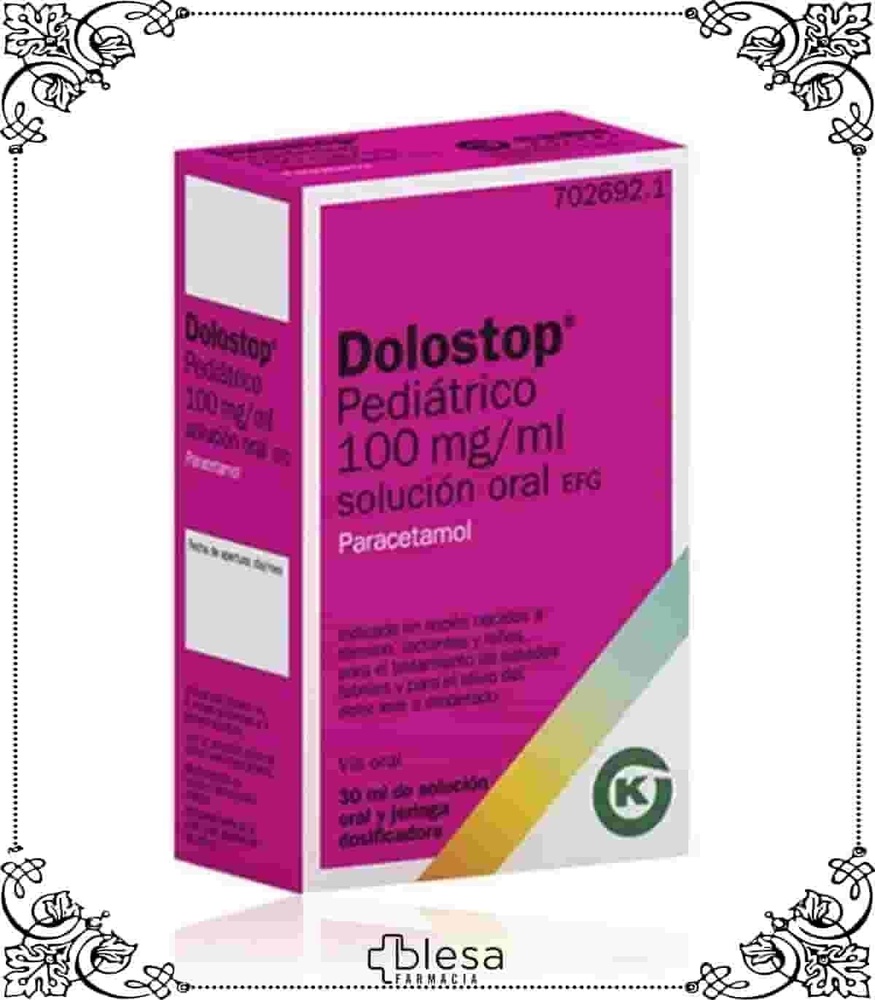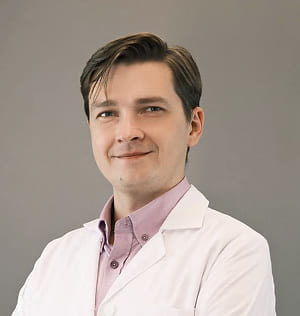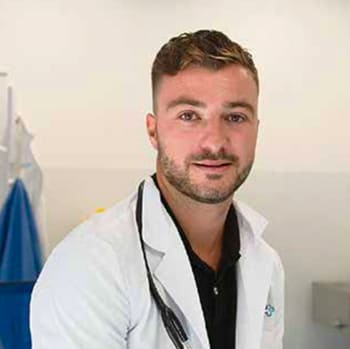

DOLOSTOP PEDIÁTRICO 100 mg/mL SOLUÇÃO ORAL

Pergunte a um médico sobre a prescrição de DOLOSTOP PEDIÁTRICO 100 mg/mL SOLUÇÃO ORAL

Como usar DOLOSTOP PEDIÁTRICO 100 mg/mL SOLUÇÃO ORAL
Introdução
Prospecto: Informação para o utilizador
DolostopPediátrico 100 mg/ml solução oral
Paracetamol
Leia todo o prospecto detenidamente antes de começar a tomar este medicamento, porque contém informações importantes para si.
Siga exatamente as instruções de administração do medicamento contidas neste prospecto ou as indicadas pelo seu médico, farmacêutico ou enfermeiro.
- Conserva este prospecto, pois pode ter que voltar a lê-lo.
- Se necessitar de conselho ou mais informações, consulte o seu farmacêutico.
- Se experimentar efeitos adversos, consulte o seu médico, farmacêutico ou enfermeiro, mesmo que se trate de efeitos adversos que não aparecem neste prospecto. Ver seção 4.
- Deve consultar um médico se piorar ou se não melhorar após 3 dias. Se a febre persistir durante mais de 3 dias ou a dor mais de 3 dias em crianças (2 dias para a dor de garganta).
Conteúdo do prospecto:
- O que é Dolostop Pediátrico e para que é utilizado
- O que necessita de saber antes de começar a tomar Dolostop Pediátrico
- Como tomar Dolostop Pediátrico
- Possíveis efeitos adversos
- Conservação de Dolostop Pediátrico
- Conteúdo do envase e informação adicional
1. O que é Dolostop Pediátrico e para que é utilizado
Paracetamol pertence a um grupo de medicamentos chamados analgésicos e antipiréticos.
Este medicamento está indicado em recém-nascidos a termo, lactentes e crianças, para o tratamento de estados febris e para o alívio da dor leve ou moderada.
2. O que necessita de saber antes de começar a tomar Dolostop Pediátrico
Não tomeDolostopPediátrico
- Se é alérgico (hipersensível) a paracetamol ou a qualquer um dos outros componentes deste medicamento (incluídos na seção 6).
- Se padece uma doença grave do fígado.
Advertências e precauções
Consulte o seu médico ou farmacêutico antes de começar a tomar este medicamento.
- Não exceda a dose recomendada na seção 3. Para isso, verifique que não se administram simultaneamente outros medicamentos que contenham paracetamol.
- Os pacientes com doenças leves ou moderadas do fígado devem consultar com o médico antes de tomar o medicamento.
- Os pacientes com doenças do rim, coração ou pulmão, com anemia (diminuição da taxa de hemoglobina no sangue, por causa ou não de uma diminuição de glóbulos vermelhos), e em pacientes com desnutrição crônica ou desidratação devem consultar com o médico antes de tomar o medicamento.
- O consumo de bebidas alcoólicas pode provocar que paracetamol produza dano no fígado.
- Se a dor se mantém durante mais de 3 dias (2 dias para a dor de garganta) ou a febre durante mais de 3 dias, ou pioram ou aparecem outros sintomas, deve interromper o tratamento e consultar o médico. Evitar tratamentos prolongados.
Durante o tratamento com Dolostop, informe imediatamente o seu médico se:
Se tem doenças graves, como insuficiência renal grave ou sepsis (quando as bactérias e suas toxinas circulam no sangue, o que provoca danos nos órgãos), ou se padece desnutrição, alcoolismo crônico ou se também está tomando flucloxacilina (um antibiótico). Foi notificada uma doença grave denominada acidose metabólica (uma anomalia no sangue e nos líquidos) em pacientes nestas situações quando se utiliza paracetamol a doses regulares durante um período prolongado ou quando se toma paracetamol junto com flucloxacilina. Os sintomas de acidose metabólica podem incluir: dificuldade respiratória grave com respiração profunda e rápida, sonolência, sensação de mal-estar (náuseas) e vômitos.
Crianças
Deve consultar o médico antes de administrar este medicamento a crianças menores de 2 anos.
Uso deDolostopPediátrico com outros medicamentos
Comunique ao seu médico ou farmacêutico que está utilizando ou utilizou recentemente ou pudesse ter que utilizar qualquer outro medicamento.
Nãosedeveutilizarjuntocomoutrosmedicamentosparatrataradorouafebre(analgésicos/antipiréticos)amenosqueoseumédicooindique.
O Paracetamol pode aumentar a toxicidade do cloranfenicol.
Os barbitúricos podem potenciar a toxicidade do Paracetamol.
Em caso de tratamentos com anticoagulantes orais, pode ser administrado ocasionalmente como analgésico de escolha.
Em particular, se está utilizando medicamentos que contenham na sua composição algum dos seguintes princípios ativos, pois pode ser necessário modificar a dose ou a interrupção do tratamento de qualquer um deles:
- Anticoagulantes orais (acenocumarol, warfarina).
- Anticonvulsivantes (lamotrigina, fenitoína, fenobarbital, metilfenobarbital, primidona).
- Antituberculosos (isoniazida, rifampicina).
- Colestiramina (utilizado para diminuir os níveis de colesterol no sangue).
- Medicamentos utilizados para o tratamento da gota (antigotosos) (probenecid).
- Alguns medicamentos utilizados para aumentar a eliminação de urina (diuréticos do asa, como os do grupo furosemida).
- Metoclopramida e domperidona (utilizados para evitar as náuseas e os vômitos).
- Propranolol utilizado no tratamento da tensão arterial alta (hipertensão) e das alterações do ritmo do coração (arritmias cardíacas).
- Flucloxacilina (antibiótico), devido a um risco grave de alteração do sangue e dos fluidos (denominada acidose metabólica com alto desequilíbrio aniônico) que deve ser tratada urgentemente (ver seção 2).
Interferências com provas analíticas:
Se lhe vão realizar alguma prova analítica (incluindo análises de sangue, urina, provas cutâneas que utilizam alérgenos, etc.), comunique ao seu médico que está tomando este medicamento, pois pode alterar os resultados dessas provas.
Uso deDolostopPediátrico com alimentos, bebidas e álcool
Este medicamento pode ser tomado com ou sem alimentos e administrado diretamente ou diluído com água, leite ou sumo de frutas.
A utilização de paracetamol em pacientes que consomem habitualmente álcool (três ou mais bebidas alcoólicas ao dia) pode danificar o fígado.
Gravidez, lactação e fertilidade
Se está grávida ou em período de lactação, ou acredita que possa estar grávida ou tem intenção de engravidar, consulte com o seu médico ou farmacêutico antes de utilizar este medicamento.
O uso oral de paracetamol não produz efeitos indesejáveis nem na grávida, nem no feto, nem no recém-nascido. Os estudos de reprodução não mostram malformações nem efeitos tóxicos. Em caso necessário, o paracetamol pode ser usado durante a gravidez. Deve utilizar a dose mais baixa possível que reduza a dor ou a febre e utilizá-la durante o menor tempo possível. Contate com o seu médico se a dor ou a febre não diminuem ou se necessitar de tomar o medicamento com mais frequência.
O paracetamol passa para o leite materno, embora não sejam produzidas comunicações de efeitos adversos em crianças. Portanto, pode ser utilizado em mulheres em período de lactação se não exceder a dose recomendada. Deve ter precaução no caso de uso prolongado.
Condução e uso de máquinas
Pode diminuir a capacidade para conduzir ou manejar máquinas por conter propilenglicol, pois pode produzir sintomas parecidos com os do álcool.
DolostopPediátricocontém propilenglicol (E-1520)e glicose
Este medicamento contém 2,72 mg de propilenglicol em cada ml.
Se o bebê tem menos de 4 semanas de idade, consulte o seu médico ou farmacêutico, em particular se ao bebê se lhe foram administrados outros medicamentos que contenham propilenglicol ou álcool.
Este medicamento contém glicose. Se o seu médico lhe indicou que padece uma intolerância a certos açúcares, consulte com ele antes de tomar este medicamento.
3. Como tomar Dolostop Pediátrico
Siga exatamente as instruções de administração do medicamento contidas neste prospecto ou as indicadas pelo seu médico, farmacêutico ou enfermeiro. Em caso de dúvidas, pergunte ao seu médico ou farmacêutico.
Lembre-se de tomar o seu medicamento.
O seu médico lhe indicará a duração do tratamento. Não suspenda o tratamento antes, pois então não se obterão os resultados esperados. Do mesmo modo, também não utilize este medicamento por mais tempo do que o indicado pelo seu médico.
A dosagem da solução é realizada em ml (100 mg/ml), mediante a seringa para uso oral de 2 ou 5 ml.
Uso em crianças
Em crianças menores de 2 anos, a dose deve ser sempre estabelecida pelo seu médico.
Crianças de 0 a 10 anos:
A dose diária recomendada de paracetamol é de 60 mg/kg/dia, ou seja, 10 mg/kg cada 4 horas (até 6 tomas/dia) ou 15 mg/kg cada 6 horas (até 4 tomas em 24 horas). Em crianças menores de 1 ano, são preferíveis doses de 10 mg/kg.
Para a administração de 10mg/kgcom intervalo mínimo de 4 horas, a pauta recomendada é a seguinte:
Peso da criança | Idade (orientativo) | Volume/toma em ml | quantidade de paracetamol/toma em mg |
3 - 4 kg | de 0 a 3 meses | 0,4ml | 40 mg |
4 a 8 kg | de 4 a 11 meses | 0,4-0,8ml | 40-80 mg |
8 a 10 kg | de 12 a 23 meses | 0,8-1 ml | 80-100 mg |
10 a 15 kg | de 2 a 3 anos | 1-1,5ml | 100-150 mg |
15 a 20 kg | de 4 a 5 anos | 1,5-2,0ml | 150-200 mg |
20 a 25 kg | de 6 a 8 anos | 2,0-2,5ml | 200-250 mg |
25 a 32 kg | de 9 a 10 anos | 2,5-3,2ml | 250-320 mg |
Para um cálculo direto, também pode multiplicar-se o peso da criança em kg por 0,10. O resultado são os ml de solução a administrar.
Estas doses podem ser repetidas cada 4 horas.
Alternativamente, podem ser administradas doses de 15 mg/kgcom intervalo mínimo de 6 horas. Neste caso, para um cálculo direto, pode multiplicar-se o peso da criança em kg por 0,15. O resultado são os ml de solução a administrar.
A administração do preparado está sujeita à aparência dos sintomas dolorosos ou febris. À medida que estes desaparecem, deve suspender-se esta medicação.
Se você estima que a ação deste medicamento é demasiado forte ou fraca, comunique ao seu médico ou farmacêutico.
Forma de uso e via de administração
Via oral
Instruções de uso:
1. - Abra o frasco seguindo as instruções indicadas no tampão (na primeira abertura o precinto se romperá).
2. - Introduza a seringa para uso oral, pressionando no orifício do tampão perfurado.
3. - Inverta o frasco e retire a dose necessária.
4. - Administre diretamente ou dilua com água, leite ou sumo de frutas.
5. - A seringa para uso oral deve ser lavada com água após cada toma.
Tape bem o frasco após cada administração.
Se tomar maisDolostopPediátricodo que devia
Em caso de sobredose ou ingestão acidental, consulte imediatamente o seu médico ou farmacêutico ou ligue para o serviço de Informação Toxicológica, telefone 91 562 04 20, indicando o medicamento e a quantidade ingerida.
Se ingeriu uma sobredose, deve acudir rapidamente a um Centro Médico, embora não haja sintomas, pois a menudo estes, muito graves, não se manifestam até passados 3 dias desde a ingestão da sobredose, mesmo em casos de intoxicação grave. Os sintomas por sobredose podem ser: tonturas, vômitos, perda do apetite, coloração amarelada da pele e dos olhos (icterícia) e dor abdominal.
Considera-se sobredose de paracetamol a ingestão de uma única toma de mais de 6 g em adultos e mais de 100 mg por kg de peso em crianças. O tratamento da sobredose é mais eficaz se for iniciado dentro das 4 horas seguintes à ingestão do medicamento.
Em caso de que o paciente esteja em tratamento com barbitúricos ou padeça de alcoolismo crônico, pode ser mais suscetível a uma sobredose de paracetamol.
Se esqueceu de tomarDolostopPediátrico
Não tome uma dose dupla para compensar as doses esquecidas.
Em caso de que tenha esquecido uma dose, tome outra tão pronto quanto possível e continue com o horário habitual. No entanto, se a hora da próxima toma está muito próxima, salte a dose que esqueceu e tome a dose seguinte na sua hora habitual.
4. Possíveis efeitos adversos
Como todos os medicamentos, paracetamol pode produzir efeitos adversos, embora nem todas as pessoas os sofram.
Este medicamento pode produzir os seguintes efeitos adversos:
- Raros (podem afetar até 1 de cada 1.000 pessoas): mal-estar, níveis aumentados de transaminases hepáticas e queda de tensão.
- Muito raros (podem afetar até 1 de cada 10.000 pessoas): reações graves na pele, alterações do fígado (como icterícia), queda de glicose, alterações sanguíneas (trombocitopenia, agranulocitose, leucopenia, neutropenia, anemia hemolítica), urina turva e alterações do rim.
- De frequência não conhecida (não pode ser estimada a partir dos dados disponíveis): Uma doença grave que pode fazer com que o sangue seja mais ácido (denominada acidose metabólica) em pacientes com doença grave que utilizam paracetamol (ver seção 2).
Comunicação de efeitos adversos
Se experimentar qualquer tipo de efeito adverso, consulte com o seu médico ou farmacêutico, mesmo que se trate de efeitos adversos que não aparecem neste prospecto. Também pode comunicá-los diretamente através do Sistema Espanhol de Farmacovigilância de Medicamentos de uso humano: www.notificaram.es. Mediante a comunicação de efeitos adversos, pode contribuir para fornecer mais informações sobre a segurança deste medicamento.
5. Conservação de Dolostop Pediátrico
Mantenha este medicamento fora da vista e do alcance das crianças.
Conservar o frasco no embalagem exterior para protegê-lo da luz.
Não utilize este medicamento após a data de validade indicada no envase após “CAD”. A data de validade é o último dia do mês que se indica.
Uma vez aberto, o conteúdo do frasco deve ser utilizado em 6 meses.
Os medicamentos não devem ser jogados nos deságues nem na lixeira. Deposite os envases e os medicamentos que não necessita no Ponto SIGRE da sua farmácia habitual. Em caso de dúvida, pergunte ao seu farmacêutico como se livrar dos envases e dos medicamentos que não necessita. Dessa forma, ajudará a proteger o meio ambiente.
6. Conteúdo do envase e informação adicional
Composição deDolostopPediátrico
- O princípio ativo é paracetamol. Cada ml de solução contém 100 mg de paracetamol.
- Os demais componentes (excipientes) são: macrogol 600, glicerol (E-422), sucralosa (E-955), mascarador do sabor (contém propilenglicol (E-1520)) aroma de fresa (contém propilenglicol (E-1520)), vermelho carmim (E-120) (contém glicose) e água.
Aspecto do produto e conteúdo do envase
Dolostop Pediátrico 100 mg/ml solução oral se apresenta em forma de solução transparente, de cor vermelha e com odor característico a fresa.
Envase de 30 ml:
Frasco de plástico (PET) transparente com 30 ml de solução oral, com um adaptador de plástico (LDPE) para inserir a seringa dosificadora e fechado mediante um tampão de plástico (HDPE). Inclui-se uma seringa de plástico de 2 ml.
Envase de 60 ml:
Frasco de plástico (PET) transparente com 60 ml de solução oral. Com um adaptador de plástico (LDPE) para inserir a seringa dosificadora e fechado mediante um tampão de plástico (HDPE). Inclui-se uma seringa de plástico de 5 ml.
Titular da autorização de comercialização e responsável pela fabricação
Kern Pharma, S.L.
Vênus, 72 - Pol. Ind. Colón II
08228 Terrassa - Barcelona
Espanha
Data da última revisão deste prospecto:Fevereiro 2025
A informação detalhada e atualizada deste medicamento está disponível na página web da Agência Espanhola de Medicamentos e Produtos Sanitários (AEMPS) http://www.aemps.gob.es/.
- País de registo
- Substância ativa
- Requer receita médicaNão
- Fabricante
- Esta informação é apenas para referência e não constitui aconselhamento médico. Consulte sempre um médico antes de tomar qualquer medicamento. A Oladoctor não se responsabiliza por decisões médicas baseadas neste conteúdo.
- Alternativas a DOLOSTOP PEDIÁTRICO 100 mg/mL SOLUÇÃO ORALForma farmacêutica: COMPRIMIDO, 1 gSubstância ativa: paracetamolFabricante: Uxa Farma S.A.Requer receita médicaForma farmacêutica: COMPRIMIDO, 1 gSubstância ativa: paracetamolFabricante: Laboratorios Cinfa S.A.Não requer receita médicaForma farmacêutica: COMPRIMIDO, 1 gSubstância ativa: paracetamolFabricante: Laboratorios Cinfa S.A.Não requer receita médica
Alternativas a DOLOSTOP PEDIÁTRICO 100 mg/mL SOLUÇÃO ORAL noutros países
As melhores alternativas com o mesmo princípio ativo e efeito terapêutico.
Alternativa a DOLOSTOP PEDIÁTRICO 100 mg/mL SOLUÇÃO ORAL em Polónia
Alternativa a DOLOSTOP PEDIÁTRICO 100 mg/mL SOLUÇÃO ORAL em Ukraine
Médicos online para DOLOSTOP PEDIÁTRICO 100 mg/mL SOLUÇÃO ORAL
Avaliação de posologia, efeitos secundários, interações, contraindicações e renovação da receita de DOLOSTOP PEDIÁTRICO 100 mg/mL SOLUÇÃO ORAL – sujeita a avaliação médica e regras locais.















